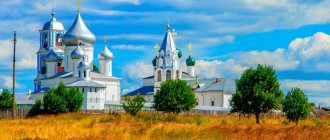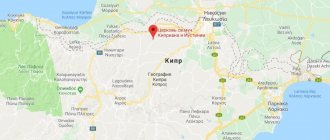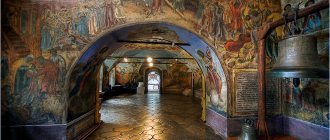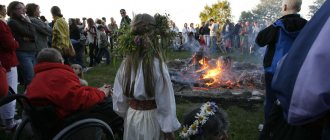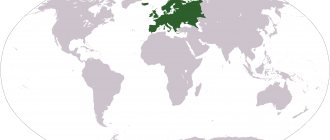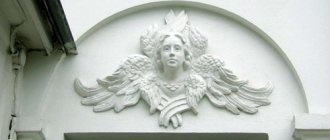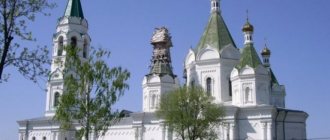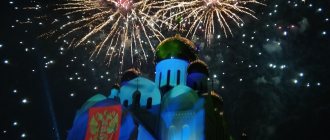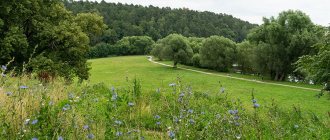Mir
Russia Yaroslavl region Pereslavl-Zalessky Church of the Forty Martyrs of Sebaste (Pereslavl-Zalessky) Map is loading…
{"format":"leaflet","minzoom":false,"maxzoom":false,"limit":50,"offset":0,"link":"all","sort":[""], "order":[],"headers":"show","mainlabel":"","intro":"","outro":"","searchlabel":"\u2026 \u0441\u043b\u0435\ u0434\u0443\u044e\u0449\u0438\u0435 \u0440\u0435\u0437\u0443\u043b\u044c\u0442\u0430\u0442\u044b","default":"","import-annotation":false,"width ":"auto","height":"350px","centre":{"text":"","title":"""link":"""lat":56.7352800000000030422597774304449558258056640625,"lon": 38.82833000000000112095221993513405323028564453125,"icon":""},"title":"","label":"","icon":"","lines":[],"polygons":[],"circles":[ ],"rectangles":[],"copycoords":false,"static":false,"zoom":8,"defzoom":14,"layers":["OpenStreetMap"],"image layers":[] ,"overlays":[],"resizable":false,"fullscreen":true,"scrollwheelzoom":true,"cluster":false,"clustermaxzoom":9,"clusterzoomonclick":true,"clustermaxradius":80, "clusterspiderfy":true,"geojson":"","clicktarget":"","showtitle":true,"hidenamespace":false,"template":"","userparam":"","activeicon": "","pagelabel":false,"ajaxcoordproperty":"","ajaxquery":"","locations":[{"text":"\u003Cb\u003E\u003Ca href=\"/palomnik/%D0% A6%D0%B5%D1%80%D0%BA%D0%BE%D0%B2%D1%8C_%D0%A1%D0%BE%D1%80%D0%BE%D0%BA%D0%B0_% D0%9C%D1%83%D1%87%D0%B5%D0%BD%D0%B8%D0%BA%D0%BE%D0%B2_%D0%A1%D0%B5%D0%B2%D0% B0%D1%81%D1%82%D0%B8%D0%B9%D1%81%D0%BA%D0%B8%D1%85_(%D0%9F%D0%B5%D1%80%D0%B5 %D1%81%D0%BB%D0%B0%D0%B2%D0%BB%D1%8C-%D0%97%D0%B0%D0%BB%D0%B5%D1%81%D1%81% D0%BA%D0%B8%D0%B9)\» title=\»\u0426\u0435\u0440\u043a\u043e\u0432\u044c \u0421\u043e\u0440\u043e\u043a\u0430 \u041c\u0443\u0447 \u0435\u043d\u0438\u043a\u043e\u0432 \u0421\u0435\u0432\u0430\u0441\u0442\u0438\u0439\u0441\u043a\u0438\u0445 (\u041f\u0435\ u0440\u0435\u0441\u043b\ u0430\u0432\u043b\u044c-\u0417\u0430\u043b\u0435\u0441\u0441\u043a\u0438\u0439)\»\u003E\u0426\u0435\u0440\u043a\u043e\u0432\ u044c\u0421\u043e\ u0440\u043e\u043a\u0430 \u041c\u0443\u0447\u0435\u043d\u0438\u043a\u043e\u0432 \u0421\u0435\u0432\u0430\u0441\u0442\u0438\u0 439\u0441\u043a\u0438\u0445 ( \u041f\u0435\u0440\u0435\u0441\u043b\u0430\u0432\u043b\u044c-\u0417\u0430\u043b\u0435\u0441\u0441\u043a\u0438\u0439). a\u003E\u003C/b \u003E\u003Chr /\u003E\u003Ca href=\"/palomnik/%D0%A1%D0%B2%D0%BE%D0%B9%D1%81%D1%82%D0%B2%D0%BE:% D0%90%D0%BD%D0%BD%D0%BE%D1%82%D0%B0%D1%86%D0%B8%D1%8F\" title=\"\u0421\u0432\u043e\u0439\ u0441\u0442\u0432\u043e:\u0410\u043d\u043d\u043e\u0442\u0430\u0446\u0438\u044f\»\u003E\u0410\u043d\u043d\u043e\u0442\u0430\u 0446\u0438\u044f\u003C /a\u003E: "'\u0426\u0435\u0440\u043a\u043e\u0432\u044c \u0421\u043e\u0440\u043e\u043a\u0430 \u043c\u0443\u0447\u0435\u043d\u 0438\u043a\u043e\ u0432\u0421\u0435\u0432\u0430\u0441\u0442\u0438\u0439\u0441\u043a\u0438\u0445"\u003Cspan class=\"smw-highlighter\" data-type=\"2\" data-state= \»persistent\» data-title=\»\u0418\u043d\u0444\u043e\u0440\u043c\u0430\u0446\u0438\u044f\» title=\»\u0026#039;\u0026#039;\u0026# 039;\u0426\u0435\u0440\u043a\u043e\u0432\u044c \u0421\u043e\u0440\u043e\u043a\u0430 \u043c\u0443\u0447\u0435\u043d\u0438\u0 43a\u043e\u0432\u0421\u0435 \u0432\u0430\u0441\u0442\u0438\u0439\u0441\u043a\u0438\u0445\u0026#039;\u0026#039;\u0026#039; 2014 \u0432 \u0433\u043e\u0440\u043e \u0434\u0435 \u041f\u0435\u0440\u0435\u0441\u043b\u0430\u0432\u043b\u044c-\u0417\u0430\u043b\u0435\u0441\u0441\u043a\u0438\ u0439. \u0410\u0434\u043c\u0438\u043d\u0438\u0441\u0442\u0440\u0430\u0442\u0438\u0432\u043d\u043e\u043e\u0442\u043d\u043e\u0441\u 0438\u0442\u0441\u044f\u043a \u041f\u0435\u0440\u0435\u0441\u043b\u0430\u0432\u0441\u043a\u043e\u043c\u0443 \u0431\u043b\u0430\u0433\u043e\u0447\u0438\u 043d\u0438\u044e\u041f\u0435 \u0440\u0435\u0441\u043b\u0430\u0432\u0441\u043a\u043e\u0439 \u0435\u043f\u0430\u0440\u0445\u0438\u0438. \u0426\u0435\u0440\u043a\u043e\u0432\u044c \u043d\u0430\u0445\u043e\u0434\u0438\u0442\u0441\u044f \u0432 \u0443\u0441\u0442 \u044c\u0435 \u0440\u0435\u043a \u0438 \u0422\u0440\u0443\u0431\u0435\u0436 \u0432 \u0438\u0441\u0442\u043e\u0440\u0438\u0447\u0435\u0441\u043a\u043e\u0439 \u0420\u044b\u0431\u043d\u043e \u0439 \u0441\u043b\u043e\u0431\u043e\u0434\u0435 \u043d\u0430 \u0431\u0435\u0440\u0435\u0433\u0443 \u041f\u043b\u0435\u044 9\u0435\u0435\u0432\u0430\u043e \u0437\u0435\u0440\u0430.\»\u003E\u003Cspan class=\»smwtext\»\u003E \u2026 \u003C/span\u003E\u003Cspan class=\»smwttcontent\»\u003E»'\u0426\u0435\ u0440\u043a\u043e\u0432\u044c \u0421\u043e\u0440\u043e\u043a\u0430 \u043c\u0443\u0447\u0435\u043d\u0438\u043a\u043e\u0432 \u 0421\u0435\u0432\u0430\u0441\ u0442\u0438\u0439\u0441\u043a\u0438\u0445"' \u2014 \u043f\u0440\u0430\u0432\u043e\u0441\u043b\u0430\u0432\u043d\u0430\u044f \u0446\u0435\u0440\u043a\ u043e\u0432\u044c \u0432 \u0433\u043e\u0440\u043e\u0434\u0435 \u041f\u0435\u0440\u0435\u0441\u043b\u0430\u0432\u043b\u044c-\ u0417\u0430\u043b\u0435\u0441 \u0441\u043a\u0438\u0439. \u0410\u0434\u043c\u0438\u043d\u0438\u0441\u0442\u0440\u0430\u0442\u0438\u0432\u043d\u043e\u043e\u0442\u043d\u043e\u0441\u 0438\u0442\u0441\u044f\u043a \u041f\u0435\u0440\u0435\u0441\u043b\u0430\u0432\u0441\u043a\u043e\u043c\u0443 \u0431\u043b\u0430\u0433\u043e\u0447\u0438\u 043d\u0438\u044e\u041f\u0435 \u0440\u0435\u0441\u043b\u0430\u0432\u0441\u043a\u043e\u0439 \u0435\u043f\u0430\u0440\u0445\u0438\u0438. \u0426\u0435\u0440\u043a\u043e\u0432\u044c \u043d\u0430\u0445\u043e\u0434\u0438\u0442\u0441\u044f \u0432 \u0443\u0441\u0442 \u044c\u0435 \u0440\u0435\u043a \u0438 \u0422\u0440\u0443\u0431\u0435\u0436 \u0432 \u0438\u0441\u0442\u043e\u0440\u0438\u0447\u0435\u0441\u043a\u043e\u0439 \u0420\u044b\u0431\u043d\u043e \u0439 \u0441\u043b\u043e\u0431\u043e\u0434\u0435 \u043d\u0430 \u0431\u0435\u0440\u0435\u0433\u0443 \u041f\u043b\u0435\u044 9\u0435\u0435\u0432\u0430\u043e \u0437\u0435\u0440\u0430.\u003C/span\u003E\u003C/span\u003E\u0439 \u0420\u044b\u0431\u043d\u043e\u0439 \u0441\u043b\u043e\u0431 \u043e\u0434\u0435\ u043d\u0430 \u0431\u0435\u0440\u0435\u0433\u0443 \u041f\u043b\u0435\u0449\u0435\u0435\u0432\u0430 \u043e\u0437\u0435\u0440\u 0430.","title":"\ u0426\u0435\u0440\u043a\u043e\u0432\u044c \u0421\u043e\u0440\u043e\u043a\u0430 \u041c\u0443\u0447\u0435\u043d\u0438\u043a\u0 43e\u0432\u0421\u0435\u0432\ u0430\u0441\u0442\u0438\u0439\u0441\u043a\u0438\u0445 (\u041f\u0435\u0440\u0435\u0441\u043b\u0430\u0432\u043b\u044c-\u0417\u0 430\u043b\u0435\u0441\ u0441\u043a\u0438\u0439)","link":"","lat":56.7352800000000030422597774304449558258056640625,"lon":38.82833000000000112095221993513405 323028564453125,"icon":""}],"imageLayers":[]}
56.735215; 38.828564
Russia, Yaroslavl region, Pereslavl-Zalessky, Levaya Naberezhnaya street, 165
Pereslavl-Zalessky, Yaroslavl region 152020
Russia
Temple phone number:
+7 (48535) 3 44 83
Telephone number of the rector of the church, Archpriest Ioann Gerasimov:
+7
Church of the Forty Martyrs of Sebaste
- Orthodox Church in the city of Pereslavl-Zalessky. Administratively it belongs to the Pereslavl deanery of the Pereslavl diocese. The church is located at the mouth of the Trubezh River in the historical Rybnaya Sloboda on the shore of Lake Pleshcheevo.
History[edit]
No information has been preserved about the exact date of the founding of the parish in the Fisherman's Settlement of Pereslavl-Zalessky, but there was a church already at the beginning of the 17th century. In the patriarchal salary books for 1628 it is written: “Church of the Holy Forty Martyrs in the Posad... tribute eight altyns, four money, ten-dollar hryvnia.”
In 1652, another warm church was built next to this church and consecrated in honor of the Intercession of the Most Holy Theotokos. In the scribe books of 1653, 82 households were recorded in the parish at these churches. In the census books of 1703, the priest Father Joachim (Semyonov) is listed with them, in the parish “82 courtyards, church arable land tithe and a third, hay 9 kopecks.”
In 1726-27, both wooden churches - both cold and warm - turned out to be dilapidated, it became impossible to serve in them, and at the request of the priest Father John (Stefanov) and his parishioners, it was allowed to build new wooden churches, which were built and consecrated in 1728 . The cold church was consecrated in the same name of the Holy Sebastian Martyrs, and the warm one - in honor of the Nativity of the Blessed Virgin Mary.
Instead of these two wooden churches, in the second half of the 18th century, during the period of the rise of church construction, a stone church was built in 1755 at the expense of Moscow merchants Maxim and Ivan Shchelyagin, which now exists. There are two altars in it: in the cold one in honor of the Holy Forty Martyrs of Sebaste, and in the warm chapel - in honor of the Nativity of the Blessed Virgin Mary. There were about 200 people in the church parish at that time.
In 1805, Father Nikita (Bessonov Nikita Ilyich), who had previously been a teacher and later an inspector of the Pereslavl Theological School, was assigned to the Church of the Holy Forty Martyrs of Sebaste. In 1824, he was appointed rector of the Transfiguration Cathedral in Pereslavl and elevated to the rank of archpriest.
In 1812, Father John (Filippovsky Ivan Kuzmich), after graduating from the theological department of the Vladimir Theological Seminary, became a priest of the Church of the Holy Forty Martyrs of Sebaste; Father John died on April 15, 1865.
The land that used to belong to the church, shown in the scribe books, was taken over by the state department in 1846, which includes Rybnaya Sloboda.
Since 1850, Father Andrei (Andrei Ivanovich Sakharov) was appointed priest to the church. In 1866 he was transferred to the Smolensk Church of Pereslavl-Zalessky, and died on October 14, 1889.
Read more…
The Feat of the Forty Martyrs
The history of the exploits of the early Christians, in whose honor the throne of this church was consecrated, is interesting and instructive. They were warriors in the army of Rome. The events took place in 320 AD, when the detachment stopped near the city of Sebastia, in Lesser Armenia, which was then one of the Roman provinces. Now these lands are located in Turkey.
According to the customs of that time, a sacrifice ceremony was to take place during the pagan holiday. The Roman pagan commander Agricolaus decided that he would force 40 of his Christian warriors from Cappadocia to perform sacrifices. But they didn't agree.
And although in Rome since 313 the Christian faith was no longer officially prohibited, Agricolaus locked the soldiers in prison with threats and promises to get them to renounce Christ. About a week of persuasion did not lead to any results.
Then Agricolaus ordered the soldiers to be taken to the lake near Sebastia. It was winter. The Christians were stripped naked and forced to stand on the lake ice. In the morning, although they were icy, they were still alive. Then the Romans killed them. The martyrdom of these Christians who did not betray their faith has become a legend.
How to get there[edit]
The Church in honor of the Forty Martyrs of Sebaste is located within two kilometers from the historical center of Pereslavl-Zalessky - Alexander Nevsky Square. Ways to get there: by car or on foot. Exit from the main road following the sign to Proezdnaya Street. Parking directly next to the Temple may be limited; it is convenient to park a car; a bus is two hundred meters away along Left Embankment Street.
Address:
Pereslavl-Zalessky, Yaroslavl region, st. Left Embankment, building 165
Temple phone number:
+7 (48535) 3 44 83
Telephone number of the rector of the church, Archpriest Ioann Gerasimov:
+7
History of the Church of the Forty Martyrs of Sebaste in the 20th century
By the beginning of the last century, the walls of the temple were painted by the Pereslavl tradesman V.P. Shemanaev
. However, in the summer of 1919, a large fire occurred inside the building, due to which the wall paintings were badly damaged. It was almost completely covered with a layer of soot.
After the arrival of Soviet power, the temple was under the jurisdiction of the parish council. In 1922, the All-Russian Central Executive Committee decided to confiscate all church valuables to help the starving people of the Volga region. The Metropolitan appealed to the priests and believers not to interfere with the authorities.
The commission for the confiscation of valuables came to the temple, and priest Leonid Gilyarevsky and the parishioners presented it with two sets of liturgical utensils for the two existing church altars. Only thanks to the efforts of the director of the Pereslavl Museum, Mikhail Ivanovich Smirnov, the most valuable things - a silver censer and a 17th-century Gospel framed in a silver frame - avoided confiscation and melting down, and became part of the museum exhibition.
But the fate of M.I. Smirnova, like most people of that time, had a difficult life. In the 30s he was arrested, and he spent three years in the camps of the Turukhansk region. Later, this famous historian worked in Sergiev Posad.
The Sorokosvyatsky Church remained active until the end of the 1930s and had about 150 parishioners. Then the church was closed, and the premises were first used as a library, then for metalworking workshops, and later for a rescue station. Services here resumed in 1996.
Architecture of the Church of the Forty Martyrs of Sebaste
The Church of the Forty Martyrs of Sebaste is often called the Fourty. It looks best from the other bank of the Trubezh River, from the Right Embankment. At the beginning of the 20th century, the beautiful Vvedenskaya Church stood here. And both of these temples formed a picturesque pair, framing the river mouth. But, unfortunately, of the two churches, only one survived, on the left bank.
The basis of the Church of the Forty Martyrs is a traditional massive quadrangle, which is crowned with five domes. Typically, on stone temples, four small domes were installed at the corners of the base. But when erecting the Church of the Forty Martyrs, they did it differently, doing it in a way that was pleasant in wooden architecture. Smaller domes were installed on four pediments built on all sides. And from this the church acquired a picturesque and original appearance.
Compositionally, the building consists of three parts, which are connected to each other and stretched in one line perpendicular to the river. This is the main temple with a semicircular apse, a one-story refectory and a high three-tier bell tower with a high spire. It was added to the church later - already in the 19th century.
The outside of the church is decorated in a very unusual way, and this immediately catches your eye. It has three-row window openings, the platbands on which differ from each other. The bell tower was built in the style of its time and its external decoration also differs from the church itself. Its lower tier is decorated with rusticated walls. And the high arched openings of the two upper tiers are framed by strict semi-columns.
The church ensemble at the mouth of Trubezh is very popular among artists and photographers. Because the bright red church contrasts colorfully with the white details of the window trim and fits very harmoniously into the surrounding landscape.
Current state of the Church of the Forty Martyrs of Sebaste and visiting schedule
The church is now operational and is being actively restored. You can get there on Saturdays from 7.00 to 20.00, and on Sundays and holidays from 7.00 to 15.00.
The icon of the Forty Martyrs of Sebaste with a particle of relics became especially revered by all believers.
The Church celebrates temple and patronal holidays on March 22, 6 Sunday after Easter, September 21 and October 29.
Next to the church there is a modern embankment with benches and lanterns, a small pier and a boat station. This is a favorite diving spot for local children. At the mouth of the river there is an equipped descent to the water. The same staircase goes down to the lake. From here you can see a very beautiful view of Lake Pleshcheyevo - a real dream for photography lovers. True, photography is not allowed inside the church building itself.
Renaissance
Services in the Church of the Forty Martyrs of Sebastia resumed only in 1996, after the believers managed to return it to the fold of the Church. Long-term restoration work immediately began in the destroyed building.
Until 1999, parishioners selflessly collected funds for the renovation of their native church, the facades of which were put in order by the summer of 1998. The warm chapel of the Nativity of the Blessed Virgin Mary was soon restored for services.
With God's help and the zeal of the parishioners, a refectory was added to the building, and a new iconostasis was installed inside the main chapel. At the same time, the old traditions of the spiritual life of parishioners were revived. The doors of God's house on the shore of Lake Pleshcheevo are now open to everyone.
Temple at the Edge of Heaven
Church of the Forty Martyrs (Pereslavl-Zalessky)
The surface of the narrow ancient Trubezh River is filled with numerous wooden boats, in them parishioners and clergy from the surrounding churches, all in bright festive vestments, in the hands of banners, images, everything shines in the dawn sun, golden reflections spread along the shallow wave to the shore. There are crowds of people there, dressed up, with flowers. With the first sound of the bell, the boat procession begins its journey.
...Around the next turn of Trubezh, the expanse of the wide, sky-sized Lake Pleshcheyevo opens up. The religious procession floats between two churches standing on opposite banks of the river. The ringing of the bells intensifies. From the memoirs of Hieromartyr Evgeniy Pereslavsky (Elkhovsky): “It was a great joy and spiritual pleasure to meet this move, standing with a cross in freedom at the porch of the church (on this day I always served at the Entry, as in the main church: Fourties - assigned). From a distance the picture seemed somehow magical to me!... A wonderful living picture!”
This “picture” can still be seen in Pereslavl-Zalessky today. With few exceptions. It is no longer as crowded and solemn as before the revolutions, when Rybatskaya Sloboda Fr. For locals, this is the most expensive holiday since the Middle Ages. Nowadays there are fewer images, however, always in someone’s hands - the icon of the Holy Martyr Eugene (the priest was shot in 1937). Another difference: instead of two churches, only one remained at the mouth, Sorokosvyatskaya, the second was blown up.
But it was with the revival of Sorokosvyatskaya that the transformation of these places began after the fall of the USSR. First - the temple, then the shore, then the whole city, and then they remembered the beautiful tradition of the river religious procession...
We talk with the rector, Archpriest Ioann Gerasimov, about how the bells of the “temple on the water” shone again in Pereslavl, about the difficult and unusual history of this church, about spiritual traditions and the last days.
Archpriest John Gerasimov with parishioners. Photo: 40s.pereslavl.ru
“The enemy took revenge on us because we opened the temple on Easter”
– When my mother and I came here in the 1990s, the temple looked very deplorable, there were no windows, no doors (the priest speaks tenderly, as if talking about a child), although there was a rescue station in the temple, the rescuers did not work particularly hard, the trees grew huge on the bell tower, about six meters away, there is one tree. It destroyed bricks and walls. And there (points under the dome) the crows lived. I personally climbed there to scrape out a crow’s nest, it was, maybe you won’t believe it, 80 centimeters thick, all made of wires and dry branches. The crows were flying around me in circles, and I was raking everything, raking it...
There were many rooms and offices in the altar; the winter chapel was completely built up. My mother and I moved into a medical office and lived here for about four years.
The condition of the temple at the time of its transfer to the church. It can be seen that there was a rescue station there. Photo: 40s.pereslavl.ru And I began to read akathists - this was even before the ordination - then prayers. I went to the forest to earn money for the roof; we were given a plot outside the city. I got tired, and then came and broke all the partitions here... The rescuers were given a place on the other side, but they still didn’t leave and didn’t leave, I already began to take out their things myself...
But, of course, the main problem was the water, over 80 years the lake took away 50 meters of the shore from us, the water was already approaching the bell tower itself, 5 meters remained...
– So the temple on the water could literally float away?
- Yes. I turned to one mayor and another, there was no way to help us. After praying, we began to take away the shore from the water on our own. They took 5 meters, they simply couldn’t do more. And they filled it with concrete.
More than a hundred meters along the coast were strengthened and improved. Previously, trees grew here - the temple was closed, but we opened it slightly so that people could contemplate the temple, and from here they could look at the lake and relax. In my opinion, this place has the best view! (Here the priest points out the window, behind him - wooden boats tapping on wooden walkways, trees leaning towards the surface of the water, pilgrims and tourists walk along the shore, walk in silence, because words are completely unnecessary here).
Father John with his mother and child on the porch of the church. Photo: 40s.pereslavl.ru
I’ve served, I’m already letting you kiss the Cross, and people are inviting me to the bathhouse, as they agreed
- In general, you returned grace to the place, but they say you got revenge for it...
– In 1996 we had our first Easter service! Easter was cold, and we had no heating. Someone advised us to buy a kerosene stove. I bought it, it seemed to provide warmth, we warmed ourselves. The holiday was celebrated - everything was fine, then in the morning, the next day of Easter, I came to serve, and there was so much smoke here! I wouldn’t have seen you (I’m sitting at arm’s length). And the wind changed, it blew into the chimney, the stove released clouds of smoke straight into the temple. I climbed under the dome, the ladder was homemade, the windows were broken, and this smoke came at me - rrrraaaz! The smoke went out before people arrived, but the smell lasted for probably three years. And that means, let me serve the service, I’ve served, I’m already letting you kiss the Cross, and people invite me to the bathhouse, as they agreed, one, the other: “Father, I’ll light the bathhouse, come!” I say: “No, no, don’t, I don’t take a steam bath.” I came home, I looked in the mirror - I was all black! That’s how all black served, it turns out! This was the temptation we had, this is how the enemy took revenge on us for opening the temple on Easter.
But I remember how many people there were then, how joyful and bright all the people were, it really felt like the temple had been resurrected!
Photo: 40s.pereslavl.ru
"Maybe it was the dawn before death"
– They say that a lot of people were baptized in your church in those years. Almost all of Pereslavl. And now they come from other cities to be baptized...
“It so happened, either the water attracts or something else, but here, however, a lot of people were baptized. I have personally baptized over 7 thousand people since I was ordained in 1995. Then I began to ask other priests to baptize.
– Are they baptized because the place is beautiful, or is there still an awareness of the sacrament?
– We talk with those who want to be baptized and with future godparents, we talk about God, about faith, about spiritual life... When you talk, Baptism goes easier, and they are more conscious and understanding. It happens that a person comes to a conversation with completely boring, glassy eyes, he looks completely heavy, and you begin to tell him the Word of God. Half the conversation will pass, you look, and his eyes are already lighting up, this is how the Word of God acts on a person’s soul! At the end he asks questions. Here was a case: two young men and a girl came for a conversation, all three were chewing gum, sat down in front of me and chewed. I say: “We need to spit out the gum.” They ran, spat out, came and looked with stone eyes. It was so hard for me to speak into those eyes, very hard! That's how bad the world can be. But I began to speak, overcoming myself. And you can’t even imagine how their views changed after half an hour of our conversation; at the end of the conversation they are completely different people! The Lord came so that man would change, become better, purer, kinder, and have more love. People are standing in the temple - who are they? These may be former murderers, former thieves, harlots, adulterers, but the Lord touched their souls - and the person began to change. The harlot is saved from fornication, the proud from pride, the envious from envy, the lazy from sloth, the evil from malice, the thief from stealing; a person discovers the richness and beauty of spiritual life, this is very interesting to watch. If faith does not change anything in a person, then the person is not on the right path, faith should change a person. This is the most important thing for which we work, for which there is a Church, a temple.
If faith does not change anything in a person, then the person is not on the right path, faith should change a person
- They say that today there is a decline in faith. This is especially noticeable by those who remember the 1990s - then entire cities were baptized, and hundreds of churches were restored absolutely disinterestedly by ordinary people...
“Maybe it was the dawn before death.” I'm afraid to even talk about what the fathers talked about; but it also seems to me that there was more combustion then. I served in the monastery in 1995, I remember: young people came to the monastery, stayed to live, and there were absolutely no amenities there, everything was destroyed, no cells, the ground was bare... And they worked, the burning was greater than now. Today, there is a lukewarmness that cannot warm oneself or ignite others - but a person must burn with love for the Lord, only this fire can ignite the hearts of other people.
– It seems to me that today is a time when love just leaves...
– It is said: “And because iniquity increases, the love of many will grow cold” (Matthew 24:12). Love is the beginning, middle and end of our entire spiritual life, we believe in God not because we are obliged to do so, we fast not because we are obliged to fast, we pray not because someone has obliged... All our religion rests on love. Whatever a person does for the sake of the Lord, he should do out of love. We know that there are three types of service to God: the first type of service is slavish, that is, a person fears God, is afraid that He will throw him into hell, and he tries to fast, fulfill the commandments, and go to church. The second ministry is the ministry of a mercenary: “Yes, Lord, I will fast, I will pray, I will keep Your commandments, I will go to temple, but You give me too! Give me drink, food, clothes, health for me, health for my children.” And there is also the service of love, just like the service of a son to his father: the son loves his father and is afraid to upset him in some way, tries to serve him with love. As the holy fathers once said: I no longer fear God, but love Him. This third service is the most prophetic, but for some reason people do not want to get closer to this service. I would like everyone to build their relationship with God at the level of love, because God is not something soulless, He is Alive.
Everything a person does for the sake of the Lord must be done out of love.
We need to build a living relationship with God, you understand. Therefore, I agree that what is lacking most today is love. We look at the iniquities around us, and for some reason our love diminishes, but we cannot identify a sinner with sin. The source of sin comes from the devil, and man must imitate God, his Creator, in humility, and in love, and so on. Sin must be hated and the sinner must be loved. It seems to me that we need to talk more about this virtue in the family. In the family, we should invest a lot in our children, not rely on school.
“I really wanted to become a priest”
– Did your family talk about faith?
– Yes, I come from a believing Ukrainian family, my grandmother and mother were very religious, they talked about God and spiritual life. These stories really hit home. Of course, we observed fasts, we were taken to church every Sunday, which also had a fruitful effect on all of us. And we were four children in the family; our mother raised us without a father. Faith has remained with us forever.
– Here I must ask about the main event in your life : how did you become a priest? Because, as far as I understand, you are a jeweler by profession, which means you were not planning to become a priest...
– I cut diamonds, and this, imagine, a pebble is smaller than a match head, and you need to put 75 facets on it. It is with this amount that a diamond acquires brilliance, play, and beauty. I did well, but my mother, who we met at work, did even better. But one day we came to my sister in Sergiev Posad. It was the beginning of the 1990s, the beginning of the collapse, it was unclear what was going on in the country, and we found ourselves in the laurels! My mother was unchurched then, and she was very surprised at the Lavra, monasticism, seminarians... I began to tell her about what my mother told me about faith, about God, about good angels, about evil angels, about saints, about heaven, about hell. She was so impressed that over time she began to tell me: let's go to the temple, let's go to the temple... And then it happened that we were offered a job at a state farm for the sake of an apartment, the state farm was next to Sergiev Posad, and we left all our diamonds, moved, got an apartment, worked, helped restore the Church of the Virgin Mary, and mother began to sing in the choir. Our spiritual formation has begun.
A year and a half later, I was offered to become a priest. It was 1995.
– How did you react to this proposal?
– I really wanted to become a priest. In Bogoroditsky I learned to read, I came home from work, read proverbs... But here I must say about the work on the farm: it is very hard, at 5 o’clock you get up for the first milking, at 7 you come back from milking, at lunch - milking again, in the evening - too most. And the people there are so kind and simple, when they saw that I go to church and pray constantly, they began to contact me to consecrate the apartment. I explained that I am not a priest. Then they began to pass notes - give for us in the temple - then, probably, my path was already determined (laughs).
Mother and I really wanted to serve God, but we didn’t dare
Mother and I really wanted to serve God, but we didn’t dare. Of course, when they suggested it, I went to my spiritual father. He said: they are not looking for the priesthood, the Lord sends it, we must accept His will. And so, with the blessing of my confessor, I leave work and come to Pereslavl.
– Why to Pereslavl?
– Hegumen Anatoly invited us here, now he is the Bishop of Kostanay and Rudny. He was then the governor of the Pereslavl monasteries and built the St. Nicholas Monastery next to our church. And so, he brought my mother and me to this temple.
“The icons fell to the ground along the way”
Photo: 40s.pereslavl.ru
– Let’s return to the dramatic history of the temple. What struck me most was how the parishioners fought for their church. They boldly came forward to meet the commission for the confiscation of church valuables and insisted that the utensils necessary for the service not be taken from the church. And they were listened to... Tell us about this time.
– We must begin with the fact that Hieromartyr Evgeniy (Elkhovsky) served here for 12 years, then he was transferred to the St. Nicholas Monastery. He put a lot of work here, they loved him very much, they built a house for him next to the temple. He performed his main service across the river, in the Vvedensky Church - it was blown up. Oh, what a pity! It was such a harmony of beauty! Two temples at the mouth of the river, on both sides of the water... And when they blew it up, they drove up to blow up our temple too. They even lined it with explosives, and people, local fishermen, began to ask: “Don’t blow it up, we got married here, we were baptized here, we invested our money with the whole Fisherman’s Settlement, we made icons, an iconostasis, we plastered…”. They even came up with this trick: leave, they say, the temple at least as a lighthouse - we can’t see it from the lake where the river mouth is. And it’s true, the mouth is not visible from the lake, I once swam to the middle, and everything flows out from there. And due to the requests of the fishermen, this temple was left and not blown up. In gratitude, the temple bell ringer rang the bells for several years during fog to give the fishermen a guide. So that they can hear where the temple is.
After Father Evgeniy, Father Leonid (Gilyarovsky) was appointed, under whom they fought the commission to confiscate church valuables. In those days, he was often dragged around the courts for interrogation. Father Leonid was shot as “the organizer of an anti-Soviet group of counter-revolutionary clergy.” This happened on December 10, 1937. A month and a half after Evgeniy’s father was shot. Since then, no one has served here.
“But, as I understand it, there was a headman here who became a legend.” And he managed to preserve the temple for decades.
– Yes, there was the elder Peter, such a servant of God, he had the keys to the temple. And everything in the temple - the iconostasis, the sacristy, the candlesticks - everything remained in the temple until 1965, that is, while he lived. And then the temple was open, and then children began to run around, various people stole the iconostasis. Old-timers recalled that someone arrived on a cart, loaded the entire iconostasis and took it away; the icons fell to the ground along the way. I looked at the local museum: there is not a single icon from our church, only a rich Gospel and a silver censer.
– What else is known about the headman, who he was, why he managed to negotiate with the authorities?
– He is a local fisherman, I saw his photographs somewhere, an ordinary person. There was a fish farm here, and the headman always made money from fishing and sold fish. They say he was very kind. And nothing more is known about him. How he managed to keep everything here is also unclear. I think maybe the akathists served in secret.
Archpriest John Gerasimov with parishioners. Photo: 40s.pereslavl.ru
– I can’t help but ask about shrines, miracles...
“The mercy of God is that a particle of the relics of the Forty Martyrs came to our temple, because they are the owners of this temple. The Forty Martyrs, as you know, have always been revered in Rus'; even in churches of the 15th century we see frescoes of the Forty Martyrs. For example, in the Lavra, in the Trinity Cathedral, where the relics of St. Sergius of Radonezh are, there is a large fresco of the Forty Martyrs, and the temple was painted in the first half of the 15th century.
As we know, the end of the world has always been expected. Both under the Roman emperors and under Napoleon
– You spoke several times during our conversation about the end of the world. In your opinion, are there more and more signs of death, more than what the holy fathers talked about?
“We should always watch for the signs.” The Lord calls us to vigil: “Watch and pray” (cf. Matt. 26:41). As we know, the end of the world has always been expected. They waited under the Roman emperors, they waited under Napoleon, they waited under Hitler. From the point of view of the Gospel teaching, it is very good if a person observes the signs, this means that the person is vigilant. When a person observes the spirit of Antichrist in himself, even better. Because he lives in us. “Sin” is translated from ancient Greek as “miss,” that is, having sinned, I went the wrong way, I go past God, sin quarrels us, sin quarrels children with parents, quarrels people with people, gives birth to wars, sometimes even fraternal wars. Wars are multiplying because sin is multiplying in society, anger and hatred are multiplying. It is very difficult to eradicate wars in a world of unlove.
But we need to delve into all this, see sin, see it inside ourselves, eradicate it. The Lord gives us intelligence not only so that we can comprehend certain things in today’s life, but so that we can seek Him. The Bible says: “Seek God, and your soul will live” (Ps. 68:32). To comprehend, to know God - every Christian must undertake this work, because otherwise we will be like that fig tree that the Lord cursed. It seemed like the fig tree was good, and the leaves were beautiful, lush, and the trunk was reliable, and the roots were strong, but there was no fruit! Likewise, a person can have all the gifts within himself, but not achieve the fruits of the spirit.
Church of the Forty Martyrs (Pereslavl-Zalessky)
